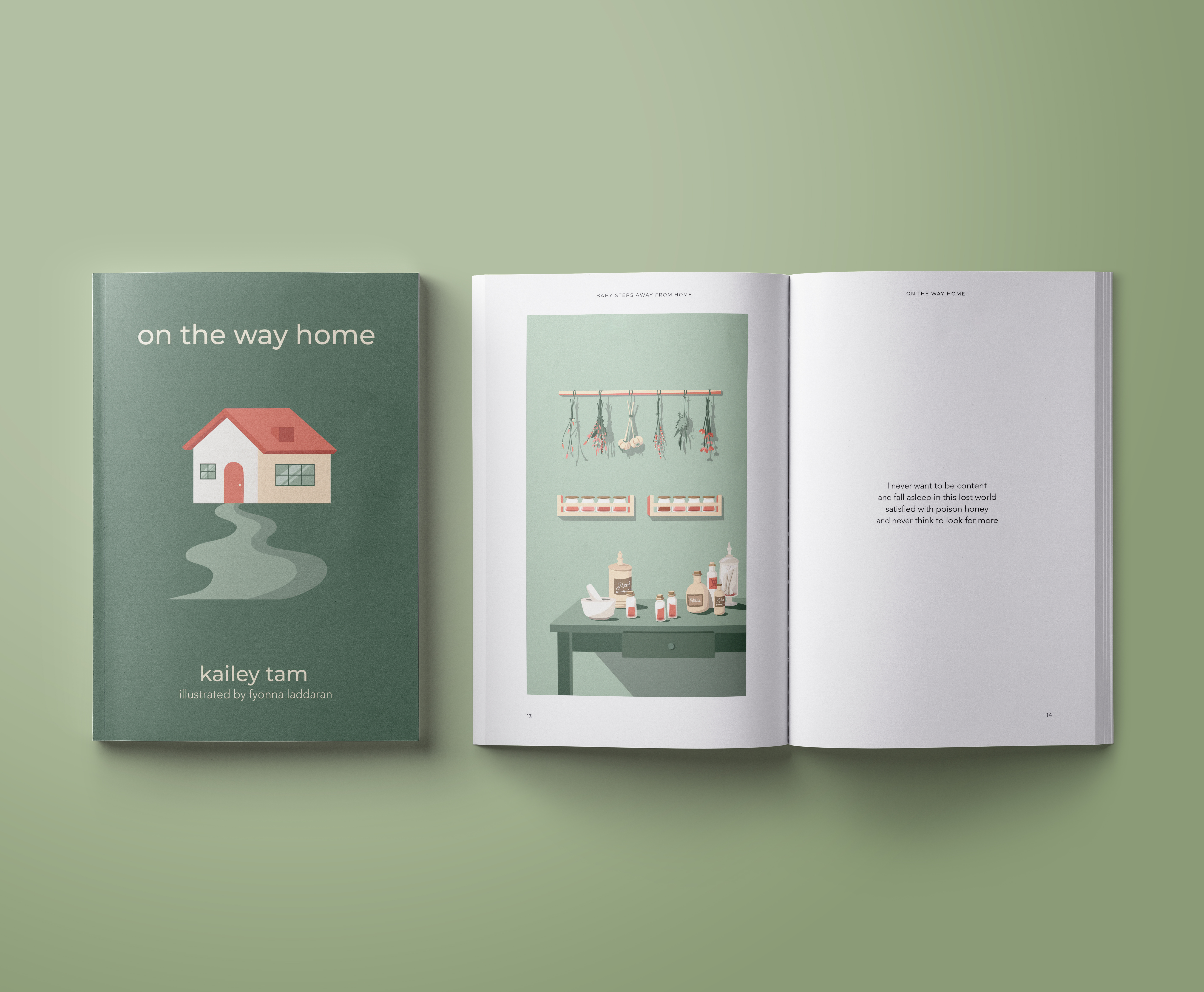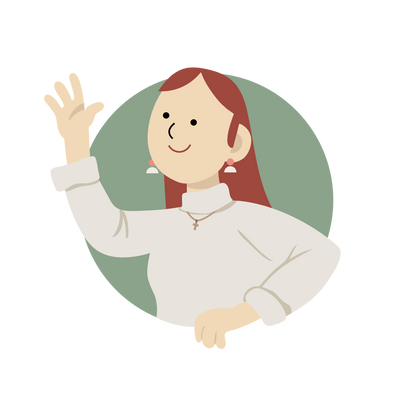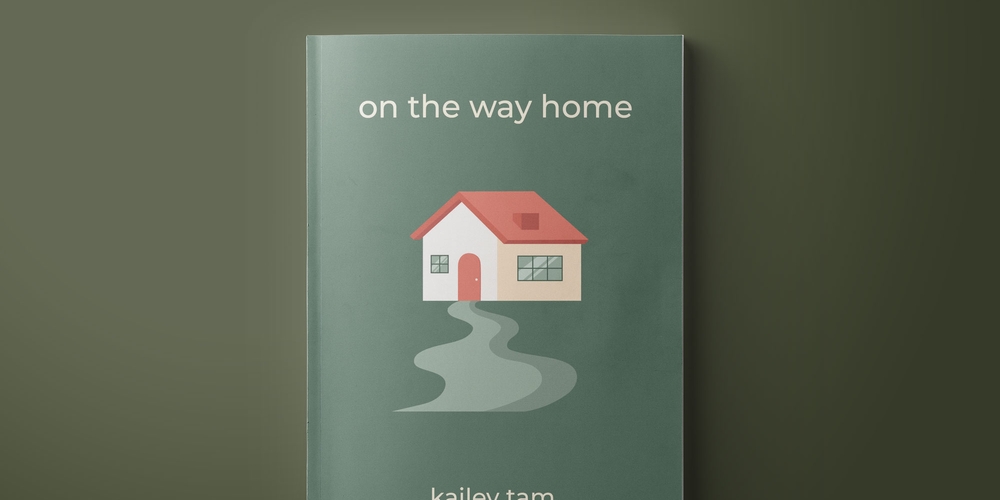the making of on the way home
Written by Kailey Tam
25/Jul/2020
I suppose I should bring it back to the beginning. A friend of mine got me a mug for my birthday—which arrived a few months after my birthday—and just so happened to be the same mug that he had already gotten for his girlfriend. I mean, I’m still grateful for the mug, of course, but Fyonna and I understandably poked fun at the gift.
“My gift is way better,” she had said, “but you won’t get it until the end of next year.”

I’m the type of person that can’t stand surprises (I look up the ending of movies while I watch them), so I nagged her enough for her to tell me what the gift was: “I’m making you a book.”
It was going to be a small-scale project, a compilation of a few of my poems into a book she’d print out at school (Emily Carr School of Art and Design).
Then March hit, and with March, the shutdown of the city. Quarantine meant the halt of school, work, friends—I spent my entire day at home, going stir-crazy and restless at my lack of productivity. (Not that productivity should be idolized or anything. I have a problem with rest so maybe that was a good thing).
In this restlessness, I was reminded of the book Fyonna had drafted up, but the idea grew bigger—what if it was a full-scale book, copyright and everything? Fyonna, in her inability to say no to me, agreed.
the first steps
The first step was choosing which poems would make the cut and how I would structure them. It came as a no-brainer to do this first book about the journey so far, but I thought it was important that the poetry followed a narrative, as obscure as it seems at times. As much as they are separate poems, they’re also part of a grander story.
After I had done that, Fyonna and I began talking mood boards. Pinterest, key words, colour palettes, art styles. I guess you could call this the research phase. I looked up different ways to get published, looked up different publishers (most of whom weren’t accepting poetry chapbooks or even submissions in general due to COVID), cost of printing. I asked my high school creative writing teacher for help.
It's interesting to see how our ideas for the book has transformed so much in so little time. Our Pinterest board is full of line drawings, chalk and oil pastels, soft yellows and blues, muted tones—which, if you’ve bought the book, you’ll know it’s nothing like that. One of the themes of on the way home is growing up, and so the first ideas I had were ones of innocence, softness, relaxedness. As the book matured in ideation, so did the images—maybe there’s a metaphor for life in there somewhere.
We spent hours dissecting each poem, talking about the kind of images/ideas I’d want to convey. I wanted to make sure the visual elements were more than a pretty image (as pretty as they are), but complementary and an additive to the verbal.
the design process
I speak as an outsider looking in. I can’t even imagine doing what Fyonna does on a daily basis, creating and designing and drawing on a tablet. So, I asked Fyonna what the design process was like for her:
K: What was the design process like for you?
F: Challenging. At the beginning, it was hard to find a style that would visually support the words but not distract or detract from them. And also, forming a consistent style. After we decided what kind of style we wanted, the process was a lot smoother.
K: I remember you getting gassed at the end too.
F: (laughs) We don’t have to mention that part. But yeah, I think I hit a point where I was looking at the words and illustrations so much that I got lost in it. It was definitely important to step away from my work, as with most of my art pieces, to get a set of fresh eyes.
K: What were some of the illustrations you found easier to draw?
F: The honey one, or the one without a title.

K: We went through a few iterations for that one.
F: It’s the one I like the most. It was the most complicated illustration in the whole book, I would say, but it was so satisfying and aesthetically pleasing to me. Also “fullness”, “dawn”, “midnight hour”, and “on the way home” were ones I had a clear vision for, so it was easier to draw them.
K: What about the more difficult ones?
F: Oh, the dragon one was really hard to draw for me (“the breakthrough” / “on vulnerability”). Some of them were harder to illustrate because the concept in the poem was hard to translate visually. I had a hard time with “tug of war” and “what I’ve learned”.
K: I love “tug of war” though. I remember telling you what I wanted for it—the two kids ripping me apart pretty much—and you were so grossed out.
F: Yeah. True story.
K: What have you learned or what would you do differently?
F: Um. I learned that I should be more careful about the printing process. And to not rush through that. Especially because it’s the final push and you just want to be done with the whole thing. Every part of the process requires an equal amount of attention and detail, especially because it’s like ours. It’s our craft. You wanna make it look good, so make it look damn good.
printing and publishing—and the mistakes that came with it
We decided to self-publish. It was the most flexible and easiest route available to us, especially as my dad runs a printing company. Let me just say, printing in colour is not cheap. If you’re wondering why a 70-page book costs 19.90—well, that’s why.
We did a first proof, fixed some things, and finalized what we’d print. I learned how to file a copyright, which was just really paying $50 to the government of Canada and receiving a certificate in the mail. I even bought an ISBN number—hence the barcode on the back of the book.
I was so excited when the books arrived at home (see my unboxing video on my Instagram highlights @wordsbykailey). Like, out of breath, freaking-out excited. It wasn’t until a few days later when I calmed down to look it over that I noticed the mistakes.
For some reason, a few of the headers are missing. There’s an image that’s slightly messed up (the rearview mirror). A footnote is missing half of its description (in “romantic period 2 a.m.” divisi should read as: used in music to instruct players to separate into different parts). And lastly, but certainly not the least, there’s a large watermark on the pages that reads “concept” with a recycling logo.
At first, we were crushed. When we had chosen the paper, we didn’t realize that the watermark came with the paper. It’s 100% recycled, hence the recycling logo. I was especially frustrated at the footnote too.
The confidence that I had in the book dropped.
If I’m honest, I got a little hesitant with sharing it in general.
But I’m realizing, the rawness of the book—in its words, its images—isn’t diminished by a few missing headers. And yeah, it’s not perfect. (Still a little frustrated by that). But the book’s also my heart, as cheesy as that is. There are poems in there that I’m still surprised I included. There are feelings in there that I’m not proud of. I don’t want to diminish the time that both Fyonna and I spent in there because of a few mistakes.
This is still one of the coolest things I’ve ever done, and despite the nervousness, I'm so excited to share it with you all.
the beginning
The roughest part of this whole thing, full disclosure, is the promo. Fyonna likes to joke that she’s my PR manager, but I wouldn’t have had this blog without her and my friend, Nicole, who coded this whole thing. I wouldn’t have all the promo videos or posts on Instagram without Fyonna. You can’t even imagine how many takes we did for our announcement video. We went to like four different locations and finally just decided to film it at Fyonna’s.
This book was really a collaborative effort of different people supporting me. My parents printing my book, Nicole coding the website, and Fyonna designing everything. Friends, strangers, old teachers, distant relatives supporting and buying the book.
This blog marks the beginning of on the way home. I’ll be releasing behind-the-scenes processes, analyses of my own poetry (for those of you guys that get a little lost when reading poetry, because honestly, same), and I guess, my own little journal entries.
Follow me on my Instagram (@wordsbykailey) and/or send me a message on the contact page to be added to the mailing list.
See you next time.
© Kailey Tam 2020. All rights reserved.

